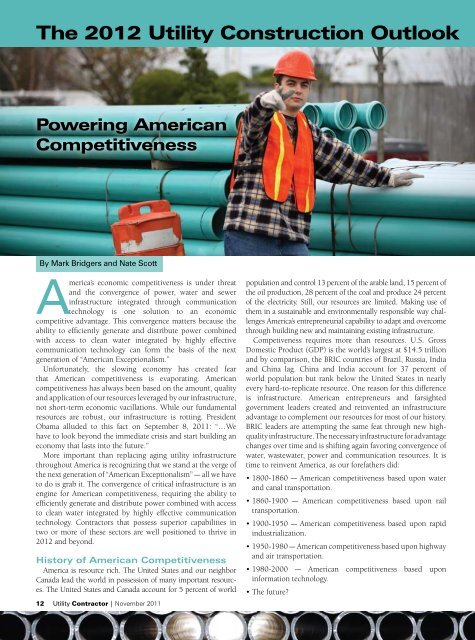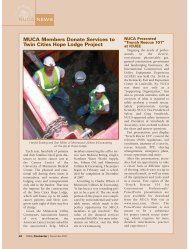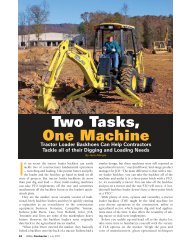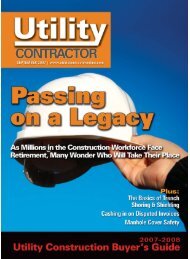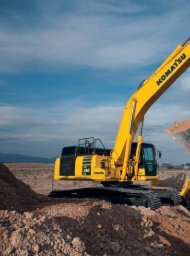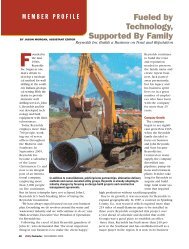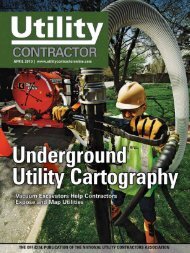View Full November PDF Issue - Utility Contractor Magazine
View Full November PDF Issue - Utility Contractor Magazine
View Full November PDF Issue - Utility Contractor Magazine
You also want an ePaper? Increase the reach of your titles
YUMPU automatically turns print PDFs into web optimized ePapers that Google loves.
The 2012 <strong>Utility</strong> Construction Outlook<br />
Powering American<br />
Competitiveness<br />
By Mark Bridgers and Nate Scott<br />
America’s economic competitiveness is under threat<br />
and the convergence of power, water and sewer<br />
infrastructure integrated through communication<br />
technology is one solution to an economic<br />
competitive advantage. This convergence matters because the<br />
ability to efficiently generate and distribute power combined<br />
with access to clean water integrated by highly effective<br />
communication technology can form the basis of the next<br />
generation of “American Exceptionalism.”<br />
Unfortunately, the slowing economy has created fear<br />
that American competitiveness is evaporating. American<br />
competitiveness has always been based on the amount, quality<br />
and application of our resources leveraged by our infrastructure,<br />
not short-term economic vacillations. While our fundamental<br />
resources are robust, our infrastructure is rotting. President<br />
Obama alluded to this fact on September 8, 2011: “…We<br />
have to look beyond the immediate crisis and start building an<br />
economy that lasts into the future.”<br />
More important than replacing aging utility infrastructure<br />
throughout America is recognizing that we stand at the verge of<br />
the next generation of “American Exceptionalism” — all we have<br />
to do is grab it. The convergence of critical infrastructure is an<br />
engine for American competitiveness, requiring the ability to<br />
efficiently generate and distribute power combined with access<br />
to clean water integrated by highly effective communication<br />
technology. <strong>Contractor</strong>s that possess superior capabilities in<br />
two or more of these sectors are well positioned to thrive in<br />
2012 and beyond.<br />
History of American Competitiveness<br />
America is resource rich. The United States and our neighbor<br />
Canada lead the world in possession of many important resources.<br />
The United States and Canada account for 5 percent of world<br />
12 <strong>Utility</strong> <strong>Contractor</strong> | <strong>November</strong> 2011<br />
population and control 13 percent of the arable land, 15 percent of<br />
the oil production, 28 percent of the coal and produce 24 percent<br />
of the electricity. Still, our resources are limited. Making use of<br />
them in a sustainable and environmentally responsible way challenges<br />
America’s entrepreneurial capability to adapt and overcome<br />
through building new and maintaining existing infrastructure.<br />
Competiveness requires more than resources. U.S. Gross<br />
Domestic Product (GDP) is the world’s largest at $14.5 trillion<br />
and by comparison, the BRIC countries of Brazil, Russia, India<br />
and China lag. China and India account for 37 percent of<br />
world population but rank below the United States in nearly<br />
every hard-to-replicate resource. One reason for this difference<br />
is infrastructure. American entrepreneurs and farsighted<br />
government leaders created and reinvented an infrastructure<br />
advantage to complement our resources for most of our history.<br />
BRIC leaders are attempting the same feat through new highquality<br />
infrastructure. The necessary infrastructure for advantage<br />
changes over time and is shifting again favoring convergence of<br />
water, wastewater, power and communication resources. It is<br />
time to reinvent America, as our forefathers did:<br />
• 1800-1860 — American competitiveness based upon water<br />
and canal transportation.<br />
• 1860-1900 — American competitiveness based upon rail<br />
transportation.<br />
• 1900-1950 — American competitiveness based upon rapid<br />
industrialization.<br />
• 1950-1980 — American competitiveness based upon highway<br />
and air transportation.<br />
• 1980-2000 — American competitiveness based upon<br />
information technology.<br />
• The future?


